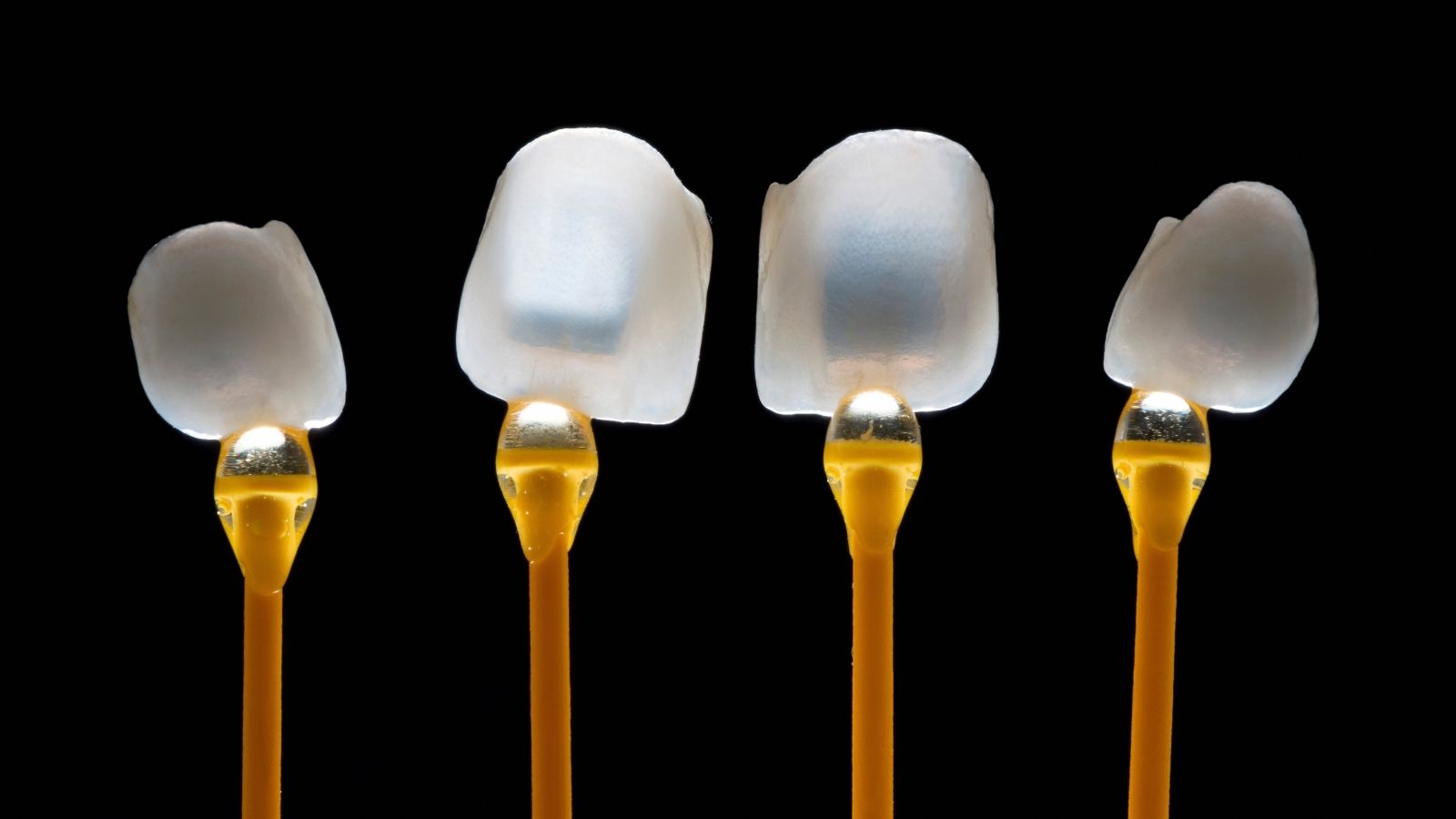Closing gaps with a filling is the process of filling the spaces between teeth (diastema) using a white filling material called composite. This increases the width of the teeth and eliminates the appearance of the existing gap. It’s often used for small or medium-sized gaps in the front teeth and involves simply widening the tooth shape without changing the tooth position. Because the procedure can usually be completed in a single, painless session, it offers a quick and effective cosmetic solution.
What is Closing Gapped Teeth with a Filling?
Closing gaps with a filling is a method of eliminating gaps between teeth by adding a composite filling material. In this procedure, a material that matches the teeth’s natural color is added to the teeth and the teeth are reshaped. Because the gap is filled with the filling material, the gap between the teeth is closed, creating a more aesthetically pleasing appearance.
This method provides quicker results than orthodontic treatments. Because the position of the teeth is not altered, the material added to the gap widens the edges of the tooth, creating a more aesthetically pleasing appearance.
No abrasion is usually required before the procedure. However, sometimes a small roughening can be done.
After the procedure, the patient can immediately look in the mirror with their new smile and see that the gap between their teeth has closed.
In Which Situations is Closing Gapped Teeth with Fillings Preferred?
Closing gaps with fillings is generally preferred for small to medium-sized gaps in the front teeth. The causes of gaps between teeth can vary, but when the gap size exceeds certain limits, fillings alone may be insufficient.
If the gap between teeth is minimal, the side of the tooth can be widened by adding a composite, maintaining the natural dimensions.
For very large diastemas, other approaches (e.g., first orthodontic correction, followed by composite touch-ups) may be used, as adding a composite alone can make the teeth appear excessively wide.
Some patients prefer fillings due to the length or cost of orthodontic treatment. Similarly, it offers a conservative option for those who prefer not to have their teeth cut or are reluctant to undergo more invasive procedures such as porcelain veneers.
For individuals with numerous cavities, composite bonding can be applied to several teeth simultaneously, reducing the spaces between all teeth. This improves the overall appearance of the teeth in a single visit.
If the teeth are small or structurally narrower than desired, a more proportionate size can be achieved with the addition of a filling.
How is Filling Applied to Close Gapped Teeth?
Closing gaps with a filling involves gradually adding and curing a white filling material called composite to the tooth surface. During this process, tissue is generally not removed from the teeth; instead, it is cleaned and roughened, and the gap is filled with composite.
First, the teeth are cleaned and isolated from saliva. This allows the filling material to adhere better to the tooth surface.
The tooth surface can then be slightly roughened; this is called “acid etching.” In the next step, a special bonding agent is used, and when light-cured, a strong bond is created between the tooth and the material.
The composite is applied in layers. The material added to both edges of the tooth is cured using light. Subsequent layers are shaped in a similar manner.
Contact points and tooth contours are accurately created. Thin plastic bands or clear strips are used to prevent the composite from bleeding into unwanted areas.
After the material has completely hardened, the dentist files and shapes it to match the tooth’s natural shape. A shiny and smooth composite surface is important for long-term durability and aesthetics.
Finally, the polishing and buffing step follows. This step allows the composite to attain a shine similar to tooth enamel.
What Materials Are Used to Fill Gapped Teeth?
Composite resin fillings are used to fill gaps, and the greatest advantage of this material is its ability to match the natural tooth color. For this treatment, an aesthetically pleasing composite resin filling similar to the tooth’s color is preferred.
Modern composites contain filler particles of various sizes. Some are enhanced with nanofillers for increased shine and durability.
These fillings are available in a wide variety of colors and transparencies, allowing the dentist to achieve a shade that is almost identical to the patient’s teeth.
A special liquid called a “bonding agent” or “adhesive” is also used in these procedures to strengthen the bond. This liquid fills the microscopic irregularities created on the tooth surface, increasing the adhesion of the composite material to the tooth.
Composite is a reliable material that has been used for many years and is popular for direct applications. It contains no metal and is compatible with the teeth and gums.
During treatmentNo laboratory procedures or impressions are required. The entire procedure is performed in the clinic, in the patient’s mouth.
How Durable is Filling for Gapped Teeth?
On average, fillings for gapped teeth can last between 5 and 10 years. A well-made composite filling can remain problem-free for many years if the patient maintains good oral hygiene.
Key factors affecting durability include the patient’s chewing habits, the presence of conditions such as clenching or grinding (bruxism), and their oral hygiene level.
While composite fillings are not as hard as porcelain, they offer a very durable structure for normal daily use.
Some studies indicate success rates exceeding 90 percent after 5 years for this type of diastema closure. Even if small cracks or edge fractures occur, the composite can be easily repaired.
If discoloration occurs at the filling edges over time, a simple polish or minor touch-up can restore the former glossy appearance. This contributes to the longevity of the treatment.
What Should Be Considered After Closing Gapped Teeth with Fillings?
After closing gaps with fillings, patients must be meticulous about their oral hygiene and habits. Regular brushing and flossing are crucial after the procedure to prevent plaque buildup on the edges of the composite between the teeth.
Regular dental checkups allow for early detection of potential discoloration or minor edge fractures. This allows for minor interventions to address the problem before it worsens.
Biting hard-shelled foods with your front teeth can shorten the lifespan of the composite. It’s also beneficial to avoid bad habits such as nail biting and opening hard packaging with your teeth.
If you have a habit of clenching or grinding your teeth at night, a night guard can be used with your dentist’s advice. This reduces the risk of abrasion and edge fractures in the treated areas.
Staining agents such as coffee, tea, red wine, or cigarettes can cause slight discoloration on the composite surface in the long term. Regular brushing and clinical polishing sessions are protective against this.
What are the advantages and limitations of closing gaps with fillings?
The advantage of closing gaps with fillings is that it can quickly, effectively, and affordably improve smile aesthetics. This method is highly protective because it can be applied without cutting the tooth structure and provides results in a single session.
Advantages
- Gaps can be closed with virtually no loss of natural tooth tissue.
- Anesthesia is often not needed, and the procedure is painless.
- Composite material offers an aesthetically pleasing shade and shine that matches the tooth.
- If discoloration or minor fractures occur in the future, they can be easily repaired.
- The cost is lower than methods like porcelain veneers.
Borders
- Closing very wide gaps can make teeth appear disproportionately wide. This can negatively impact aesthetics, so planning it in conjunction with orthodontics or other treatments may sometimes be necessary for large gaps.
- Because composite is not as durable as porcelain, the surface gloss may decrease over time, or small chips may develop. However, these problems can usually be easily repaired.
- The risk of fracture increases if the filling is stressed by excessively hard foods or habits.
- In the long term, slight color changes may occur on the natural tooth or the composite surface. This may require polishing or touch-ups.
How to Address Aesthetic Concerns Regarding Closing Gapped Teeth with Fillings?
Aesthetic concerns regarding closing gaps with fillings are addressed by selecting the correct shade and carefully shaping the tooth shape. The dentist aims to achieve a natural appearance by meticulously planning the composite shade and the anatomical structure of the tooth.
Before the procedure, the patient’s expectations are assessed using photographs or a digital design. This allows the patient to visualize how their teeth will look after treatment.
In some cases, a temporary “mock-up” is applied. This is a rough representation of the final shape by applying temporary composite to the tooth. The patient expresses their opinion at this stage, and revisions are made if necessary.
Different shades of composite can be applied to the tooth to ensure color compatibility and checked in the mouth. The light is examined from different angles to select the most suitable shade.
Creating the margins to match the natural tooth shape is different from a traditional filling. When closing a gap, the proportions of the teeth are taken into account.
The final polishing and surface buffing process blurs the boundary between the tooth and the filling. This makes the presence of a filling unnoticeable from an aesthetic perspective.
Covering Gapped Teeth with FillingHow Can Gapped Teeth Be Protected in the Long Term?
Closing gaps with fillings can be protected long-term with regular maintenance and dental checkups. Daily brushing and flossing with the correct technique prevents bacteria and plaque buildup at the edges of the filling.
After treatment, the dentist generally recommends six-month dental checkups. These checkups evaluate the surface gloss of the composite, its fit, and the condition of the gums.
If minor color differences or minor edge irregularities are detected, they can be quickly polished or repaired. These minor adjustments extend the life of the filling and maintain its aesthetic appearance.
Over time, teeth can experience minor movements from their natural positions. If the patient notices this early and consults the dentist, the gap can be re-sealed with a composite, or other solutions can be explored.
If there is a condition such as bruxism, where teeth are clenched with excessive force, a protective night guard protects the teeth and fillings from wear. This simple measure ensures the long-term durability of the filling.
Good eating habits also help preserve the filling. Biting very hard foods with your front teeth can lead to unwanted cracks. Furthermore, excessive consumption of acidic beverages can damage not only the composite but also your overall oral health.








